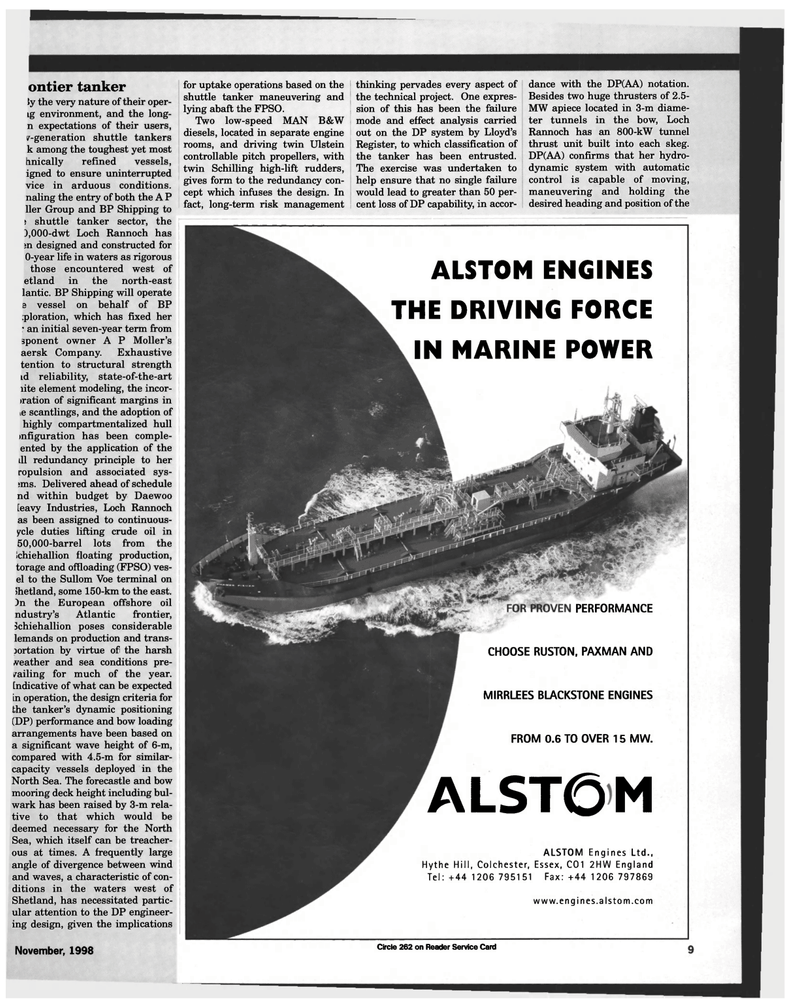
Page 9: of Maritime Reporter Magazine (November 1998)
Read this page in Pdf, Flash or Html5 edition of November 1998 Maritime Reporter Magazine
November, 1998 Circle 262 on Reader Service Card ontier tanker iy the very nature of their oper- ig environment, and the long- n expectations of their users, /-generation shuttle tankers k among the toughest yet most tinically refined vessels, igned to ensure uninterrupted vice in arduous conditions, naling the entry of both the A P ller Group and BP Shipping to s shuttle tanker sector, the ),000-dwt Loch Rannoch has )n designed and constructed for 0-year life in waters as rigorous those encountered west of etland in the north-east lantic. BP Shipping will operate e vessel on behalf of BP iploration, which has fixed her • an initial seven-year term from sponent owner A P Moller's aersk Company. Exhaustive tention to structural strength id reliability, state-of-the-art lite element modeling, the incor- iration of significant margins in ie scantlings, and the adoption of highly compartmentalized hull infiguration has been comple- ented by the application of the
L11 redundancy principle to her ropulsion and associated sys- sms. Delivered ahead of schedule nd within budget by Daewoo [eavy Industries, Loch Rannoch as been assigned to continuous- ycle duties lifting crude oil in 50,000-barrel lots from the ichiehallion floating production, torage and offloading (FPSO) ves- el to the Sullom Voe terminal on
Shetland, some 150-km to the east. )n the European offshore oil ndustry's Atlantic frontier, fchiehallion poses considerable lemands on production and trans- jortation by virtue of the harsh weather and sea conditions pre- /ailing for much of the year.
Indicative of what can be expected in operation, the design criteria for the tanker's dynamic positioning (DP) performance and bow loading arrangements have been based on a significant wave height of 6-m, compared with 4.5-m for similar- capacity vessels deployed in the
North Sea. The forecastle and bow mooring deck height including bul- wark has been raised by 3-m rela- tive to that which would be deemed necessary for the North
Sea, which itself can be treacher- ous at times. A frequently large angle of divergence between wind and waves, a characteristic of con- ditions in the waters west of
Shetland, has necessitated partic- ular attention to the DP engineer- ing design, given the implications
ALSTOM ENGINES
THE DRIVING FORCE
IN MARINE POWER for uptake operations based on the shuttle tanker maneuvering and lying abaft the FPSO.
Two low-speed MAN B&W diesels, located in separate engine rooms, and driving twin Ulstein controllable pitch propellers, with twin Schilling high-lift rudders, gives form to the redundancy con- cept which infuses the design. In fact, long-term risk management thinking pervades every aspect of the technical project. One expres- sion of this has been the failure mode and effect analysis carried out on the DP system by Lloyd's
Register, to which classification of the tanker has been entrusted.
The exercise was undertaken to help ensure that no single failure would lead to greater than 50 per- cent loss of DP capability, in accor- dance with the DP(AA) notation.
Besides two huge thrusters of 2.5-
MW apiece located in 3-m diame- ter tunnels in the bow, Loch
Rannoch has an 800-kW tunnel thrust unit built into each skeg.
DP(AA) confirms that her hydro- dynamic system with automatic control is capable of moving, maneuvering and holding the desired heading and position of the
ALSTOM Engines Ltd.,
Hythe Hill, Colchester, Essex, C01 2HW England
Tel: + 44 1206 7951 51 Fax: +44 1 206 797869 www.engines.alstom.com
ALSTOM
PERFORMANCE
CHOOSE RUSTON, PAXMAN AND
MIRRLEES BLACKSTONE ENGINES
FROM 0.6 TO OVER 15 MW.

 8
8

 10
10
